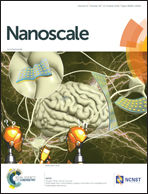Self-scrolling MoS2 metallic wires†
Abstract
Two-dimensional (2D) van der Waals (vdW) materials with strong in-plane chemical bonds and weak interaction in the out-of-plane direction have been acknowledged as a basic building block for designing dimensional materials in 0D, 1D, 2D and 3D forms. Compared to the explosive research on 2D vdW materials, quasi-one-dimensional (quasi-1D) vdW materials have received rare attention, despite the fact that they also present rich physics in electronics and engineering implications. Herein, quasi-1D MoS2 nanoscrolls are directly fabricated from CVD-grown 2D triangular MoS2 sheets. The formation, stability and electronic properties of quasi-1D MoS2 nanoscrolls are studied experimentally and theoretically. The formation of a nanoscroll always starts from the edge of a triangular MoS2 sheet along its armchair orientation. The electronic properties of MoS2 nanoscrolls are systemically studied with optical spectroscopy and electrical transport together with density-functional theory (DFT) calculations. Surprisingly, the carrier mobility and contact properties of MoS2 nanoscroll based field effect transistors (FETs) are distinct from that of 2D MoS2 sheets. The transition from a 2D semiconductor MoS2 sheet to a 1D metallic MoS2 nanoscroll is successfully achieved. It is expected that this method of fabricating MoS2 nanoscrolls will attract wide interest for 1D transition metal dichalcogenides with novel physical and chemical properties.

- This article is part of the themed collections: Nanoscale 10th Anniversary: Top Authors and 2018 Nanoscale HOT Article Collection


 Please wait while we load your content...
Please wait while we load your content...
